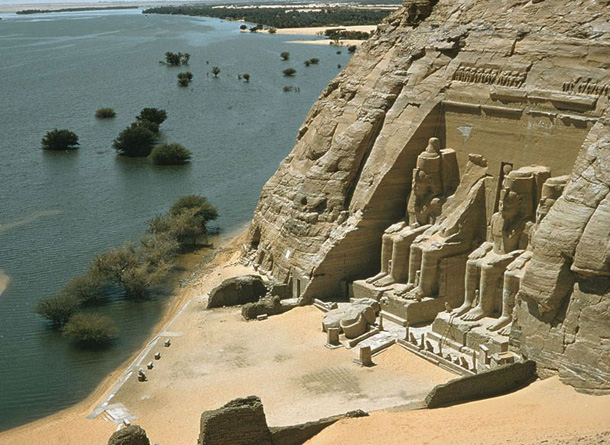 The ancient site of Damas, the cities of New Orleans and Venice, the Easter Island stat- ues, the town of Salzburg and that of Hoi An in Vietnam…
The ancient site of Damas, the cities of New Orleans and Venice, the Easter Island stat- ues, the town of Salzburg and that of Hoi An in Vietnam…
The list of the sites belonging to humanity’s patrimony and threatened by climate change doesn’t stop getting longer. A question increasingly arises here : are nations ready to commit the means necessary to safeguard this group which constitute the cultural wealth of our history by its diversity ? What was achieved in 1958 to save the site of Abu Simbel on the Nile in Egypt, because of the unavoidable flooding as a result of the Aswan High Dam’s construction was amazing feat : 60 thousand of tons of stone removed one by one, identified, numbered from one to 1600, and then re-assembled so that future generations could continue to enjoy this jewel of Paranoiac architecture. Today, we aren’t talking about one site but dozens. More often, we talk of thousands of tonnes or millions of cubic metres… we’re no longer expecting the help of a few nations but all the nations of the planet which must create a huge plan to conserve these legacies of the past.
In the face of such an undertaking’s size, realism and idealism oppose each other once again. And the same groups which stated their opposi- tion to projects such as the space elevator openly state their objection to this conservation pro- ject for a heritage which they themselves don’t recognize. These masterpieces in danger are the manifestation of a world from which they appear to be totally separated : “As the loss of the Bamiyan Buddhas contributed to crystallize the extent of the Taliban’s’ extremism in Afghanistan with the public at large at the beginning of the 21st century, these sites, buried and lost forever, will be other milestones along the long road of realization which humanity must travel to save itself from its own excesses !” Clearly, the projects’ costs are taken into account in the opponents’ approach to this major project, already called the NAS Project (New Abu Simbel Project).
For all that, the NAS doesn’t lack support. Whether from industrial or transnational patronage, cultural foundations, or quite simply via state aid of all sizes, this support has been organized be- ginning with the constitution of a scientific committee of experts. The latter, via its spokesperson, emphasizes that the current climate isn’t the same as at the time of the “first Abu Simbel”. What, at the time, constituted a Paranoiac work for the teams in the true sense of the word, could be carried out much more effectively thanks to the use of new technologies : foremost among which are robotics and artificial intelligence. “It’s not out of the question to entrust a site’s conser- vation project (analysis, selection of a new location, transfer, adaptation of the new site layout and reconstruction) to an Artificial Intelligence which would be structured around all the elements which constitute the site to be transferred (physical just as much as cultural or aesthetic constituents). Its artificial instinct of survival will supervise a myriad of robots, all controlled by this Artificial Intelligence. We can be sure that the new site which is chosen, just like the means to get it up and running and, in addition slotting it into the framework of the laws of robotics, will respect the wealth of these unique and essential sites’ in mankind’s memory much better than humans !”
The NAS scientific committee will shortly submit a programme of work to be undertaken to the UN General Assembly. The two camps are hon- ing their weapons for this verbal battle with global implications.
Special thanks to map@leap2020.eu for the translation.
© Olivier Parent – prospective.lecomptoir2.pro





 Ecko Magazine
Ecko Magazine 










